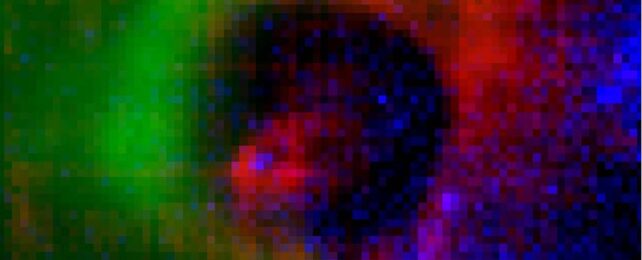A newly discovered structure located deep in the heart of a thick cloud of gas and dust more than 450 light-years away is the signature of a pair of baby stars in the throes of formation.
A team of astronomers have identified a previously unseen bubble at the center of a stellar nursery called Barnard 18 in the Taurus molecular cloud complex, likely carved from the surrounding gas as two emerging stars therein formed and grew.
It's only the second time astronomers have identified such a bubble with the ejection of material or 'outflow' associated with a growing star. The newly discovered structure could help scientists learn more about how stars affect their environment as they grow.
Star formation is a complicated, messy business. It starts with a dense, cold cloud of small grains of dust and gases including hydrogen. Eventually, a clump of this cloud collapses in a swirl under its own gravity, pulling in more material from the fog of material around it. Once it gains enough mass, the resulting pressure and heat generates the hydrogen in the core that defines stars.
But as a baby star accumulates that mass, it lashes out at the space around it. Not all material makes its way into the star; some is accelerated along the protostar's magnetic field lines towards the poles, where it launches into space as astrophysical jets. Additionally, protostars whip up winds that carve great voids into the cloud from which it's born.
These outflows are called feedback, and they're thought to play an important role in cutting off protostellar growth, as well as the evolution of the interstellar medium – the gas and dust that drifts around in the spaces between the stars.
Because molecular clouds are so dense, seeing what's happening inside them as a star forms is not particularly easy. Shorter wavelengths of light don't penetrate the cloud; but longer wavelengths can.
Barnard 18 is a dark nebula, one that neither emits nor reflects light. It appears as a dark smudge in optical observations, almost like a void in space. So, to see inside the cloud, a team of astronomers led by Yan Duan and Di Li of National Astronomical Observatories of the Chinese Academy of Sciences (NAOC) in China turned to radio wavelengths.
Using two different radio telescopes, they analyzed the carbon monoxide signal, which can be used to trace structures within a cloud of gas. And, lurking within the Barnard 18 molecular cloud, they found evidence of a bubble structure.
Further observations revealed even more.
"Through combined analysis with the Five College Radio Astronomy Observatory (FCRAO) survey of the Taurus molecular cloud, we found an outflow located at the center of the molecular bubble," says NAOC astronomer Yan Duan, first author on the team's paper.
Barnard 18 is home to a curious object that had already been identified by astronomers – a Herbig-Haro object called HH 319. These are created by protostellar jets blasting away from their source stars at incredible speeds, colliding with the molecular cloud and causing it to glow.
HH 319 is located at the center of the outflow identified by Li and his team, and this gives clues as to the origin of the bubble. But there were several possible progenitors: stars don't always sit still, no star could be seen at the center of the bubble, and a number of young stars can be found nearby.
Based on their position, the researchers traced the origin to a binary pair of T Tauri stars. Younger than a million years old, these are a type of star that haven't quite kicked off hydrogen fusion yet and are still accumulating mass. The binary, the team found, is the most likely to have moved to its current position from the center of the bubble.
According to the team's calculations, activity from the two stars around 70,000 years ago is what started carving out the giant bubble in Barnard 18.
This, the team says, demonstrates the ability of T Tauri stars to make a dramatic impact on its surrounding environment. However, future observations will be needed to confirm their findings.
The research has been published in The Astrophysical Journal.
